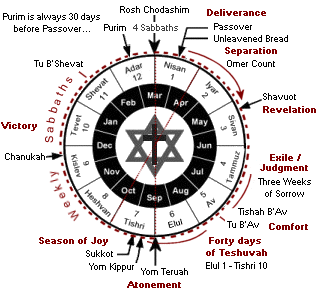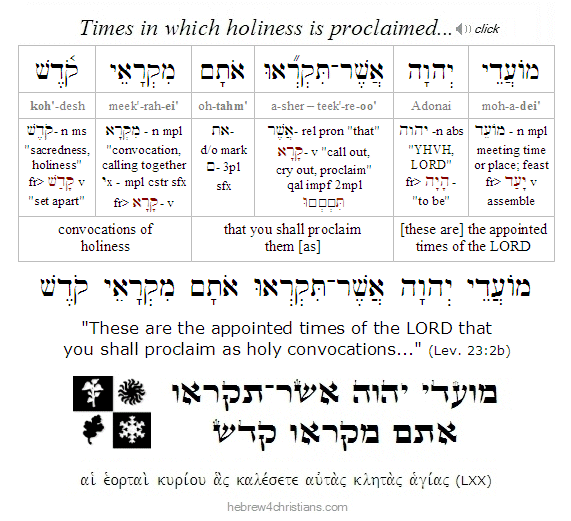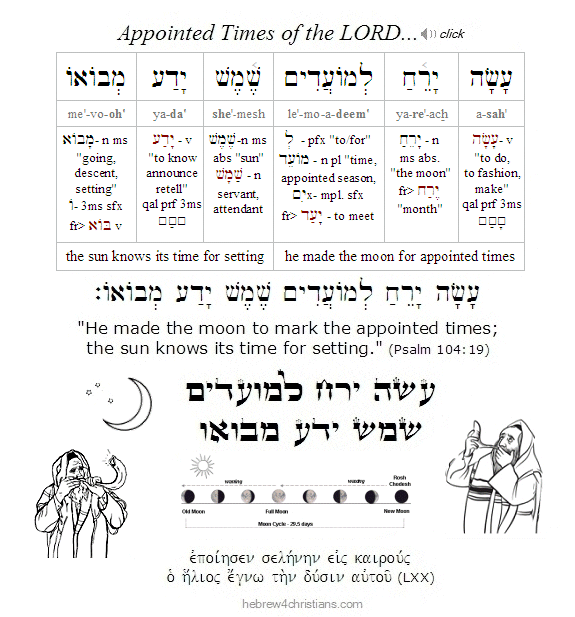|
The Holy Mo'edim...
Our Torah portion this week (parashat Emor) lists the eight main mo'edim (מוֹעֲדִים) -- the "appointed times" of the LORD given in the Jewish Scriptures. These special times are also referred to as mikra'ei kodesh (מִקְרָאֵי קדֶשׁ), "times in which holiness is proclaimed" (Lev. 23:2). Note that this is the first time that the Torah reveals a comprehensive description of the festivals of the year, including the following special times:
- The Sabbath (יום השבת) - The weekly observance of Shabbat that commemorates God as the Creator of the world. According to the sages, Shabbat is the most important of the appointed times, even more important than Yom Kippur and the Ten Days of Awe. There are 54 weekly Sabbaths in a "leap year" and 50 for regular years... In addition to the Sabbath are monthly Sabbaths (שבתות חודשיות) called Rosh Chodeshim.
- Pesach (חג פסח), also called Passover. This reveals the redemption from death that comes from the sacrificial blood of the Lamb of God...
- Unleavened Bread (חג המצות) - This denotes the sanctification of the people of God, the "crossing over" into the realm of Promise. Note that the Counting of the Omer (ספירת העומר) is also first mentioned in this section of Torah (Lev. 23:9-16).
- Firstfruits (ום בכורים), also called Reishit Katzir. This marked the first wave offering (תנופת העומר) of the new harvest which symbolized the time of the resurrection of Messiah and the victory of Life over the powers of hell and death.
- Shavuot (חג השבועות), also called "Weeks" or "Pentecost." This marks the climax of the Passover Season, the giving of Torah at Sinai and the giving of the Ruach (Spirit) at Zion. It is the advent of the New Covenant for all nations, tribes, and tongues...
- Yom Teru'ah (יום תרועה), also called "Rosh Hashanah" (note that this is the first time this is revealed in Torah). This marks the start of the final "week of years" of the End of Days and time of worldwide judgment... the "Great Tribulation."
- Yom Kippur (יום כיפור) also called the Day of Atonement. This denotes the national cleansing and restoration of the Jewish people at the end of the Tribulation Period.
- Sukkot (חג סוכות) also called "Tabernacles" (note that this is the first time the commandments to dwell in a Sukkah and to wave the arba minim (four species) are mentioned in the Torah). This denotes the Millennial Kingdom and Sukkah of God established as Zion. (The two more recent holidays of Chanukah and Purim are alluded to in this portion as well: see the parashah summary for more information.)
Notice that there is a restatement of the commandment to leave food for the poor and the stranger (pe'ah, leket, etc.) that appears in the midst of the list of the various holidays (see Lev. 23:22), which the sages said was intended to remind us to help those in need, especially during these times. Hence we see that giving of tzedakah is a regular part of the Jewish holidays (e.g., giving ma'ot chittim [מַעוֹת חִטִּים] "money for wheat" during Passover, matanot la'evyonim [מַתָּנוֹת לָאֶבְיוֹנִים] for Purim, and so on). The sages ask, "Why did the Torah place the mitzvah of helping the poor while speaking about the holidays and their particular sacrifices? To teach us the greatness of charity: 'God credits whoever gives charity to the poor as if they built the Holy Temple and presented offerings therein to God.' Giving a gift to the poor is giving a gift to God Himself!"
Since there are at least 50 weekly Sabbaths in a Jewish year in addition to the seven prescribed holidays (not to mention Rosh Chodesh and the other holidays such as Purim, Chanukah, Israel Independence Day, etc.), it is no wonder that the Scriptures declare: "A person with a cheerful heart has a continual celebration" (Prov. 15:15). The moedim are times to give thanks to the LORD for all He has done.... Rejoice in the Lord always!
 |
Notice that the calendar is divided into two equal parts of exactly six lunar months each, both of which center on redemptive rituals and end with harvests. The first half of the divine calendar begins on Rosh Chodashim (i.e., Nisan 1; Exod. 12:2), which is followed by the instructions to select the Passover lamb on Nisan 10 (Exod. 12:3), slaughter it in the late afternoon of 14th (Exod. 12:6-7) and eat it on the 15th (Exod. 12:8). The Passover itself initiated the seven day period of unleavened bread (from Nisan 15-22), wherein no leaven was to be consumed (Exod. 12:15-20). On an agricultural level, Passover represents spring, the season of the firstfruit harvests (i.e., chag ha-katzir: חַג הַקָּצִיר), and so on. On the "other side of the calendar," Yom Teruah (or Rosh Hashanah) marks the start of the second half of the year (Exod. 23:16, Lev. 23:24), which is followed by the Yom Kippur sacrifice ten days later, on Tishri 10 (Lev. 23:27), followed by the weeklong festival of Sukkot ("Tabernacles") that occurs from Tishri 15-22 (Lev. 23:34-36). On an agricultural level, Sukkot represents the reaping of the fall harvest (i.e., chag ha'asif: חַג הָאָסִף) at the "end of the year" (Exod. 23:16). In other words, in some respects the fall holidays "mirror" the spring holidays on the divine calendar, and indeed, both sides of the calendar represent different aspects of God's redemptive plan for the world. As I've written about elsewhere, the spring holidays represent the first advent of Yeshua (i.e., Yeshua as Suffering Servant, Lamb of God, Messiah ben Yosef), whereas the fall holidays represent His second advent (Yeshua as Conquering Lord, Messiah ben David).
In an attempt to include Chanukah and Purim as apart of the divine calendar revealed in the Torah, the Jewish sages note that immediately after the LORD revealed these holidays, he instructed Moses to keep the menorah in the Holy Place of the Mishkan burning continually (ner tamid) and to provide weekly "showbread," or twelve loaves of bread on the shulchan inside the Holy Place. The sages say that the instructions regarding the oil of the menorah alludes to Chanukah, whereas the lechem ha-panim ("showbread") alludes to hester panim - or "hiding of face" and the nes nistar (hidden miracle) of the Esther story.
Hebrew Lesson:
Lev. 23:2b reading (click):
Cycles of Time...
Instead of thinking of time as a linear sequence of events (i.e., the measurement of linear, progressive motion), Jewish thinking tends to regard it in terms of a spiral or "helix," with a forward progression delimited by an overarching (and divine) pattern that recurs cyclically throughout the weeks, months, and years of life. This can be seen in the Hebrew language itself. Some of the sages note that the Hebrew word for "year" - shanah (שָׁנָה) - shares the same root as both the word "repeat" (שָׁנָה) and the word "change" (שִׁנָּה). In other words, the idea of the "Jewish year" implies ongoing "repetition" - mishnah (מִשְׁנָה) - or an enduring "review" of the key prophetic events of redemptive history as they relived in our present experiences... (The idea that the events of the fathers were "parables" for us is expressed in the maxim: מַעֲשֵׂה אֲבוֹת סִימָן לַבָּנִים / ma'aseh avot siman labanim: "The deeds of the fathers are signs for the children.") The Jewish year then repeats itself thematically, but it also changes from year to year as we progress closer to the coming Day of Redemption... We see this very tension (i.e., constancy-change), for example, in the "dual aspect" of the ministry of Yeshua our Messiah. In His first advent Yeshua came as our Suffering Servant and thereby fulfilled the latent meaning of the spring holidays, and in His second advent He will fulfill the latent meaning of the fall holidays. Nonetheless, we still commemorate both the "type and its fulfillment" every year during Passover by extending the ritual of the Seder to express the reality of Yeshua as the world's "Lamb of God," just as we commemorate the fall holidays in expectation of His rule and reign as our King....
None of this is meant to suggest, by the way, that there isn't an "end point" in the process - a Day in which we will be with God and enjoy His Presence forever... The idea of the "cycles" of time, or "timeless patterns in time," suggests, however, that the "seed" for our eternal life with God has already been sown - and was indeed foreknown even from the Garden of Eden, despite the fact that we presently groan while awaiting the glory of heaven.
Hebrew Lesson
Psalm 104:19 reading (click):
|





